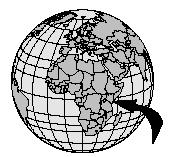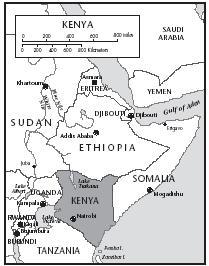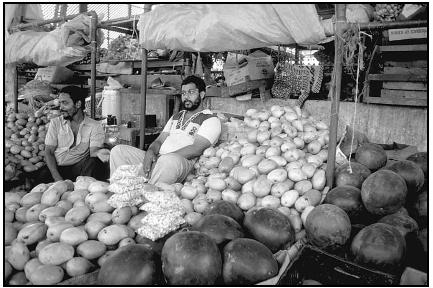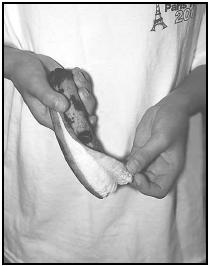Kenya
Recipes

1 GEOGRAPHIC SETTING AND ENVIRONMENT
Kenya is located in East Africa near the Equator (the imaginary line that divides the Earth into the Northern and Southern Hemispheres). The country is approximately twice the size of Nevada. The southeast part of Kenya borders the Indian Ocean. The land regions are varied and range from year-round snow in the Kenya and Kilimanjaro Mountains to warm, tropical beaches. Some of the regions are desert, but most land is rolling grasslands and forests.
Kenya's climate is as varied as the land areas. Typically, there are two rainy seasons. The highest amount of rainfall occurs in April and the least rainfall occurs in January. The evenings in the Central Highlands can be quite chilly and the coastal areas are usually hot and humid.
2 HISTORY AND FOOD
When the Portuguese arrived in 1496 on the coast of Kenya, they introduced foods from newly discovered Brazil. Maize, bananas, pineapple, chilies, peppers, sweet potatoes, and cassava were brought in and became local staples. The Portuguese also brought oranges, lemons, and limes from China and India, as well as pigs.
Pastoralism (cattle herding) has a long history in Kenya. Around A.D. 1000, a clan from North Africa called the Hima introduced cattle herding. By the 1600s, groups like the Maasai and Turkana ate beef exclusively. Cattle provided meat, milk, butter, and blood.
When the Europeans arrived at the shores of Kenya, they brought with them white potatoes, cucumbers, and tomatoes. The British imported thousands of Indians for labor, and curries (spicy dishes made with curry spice), chapattis (a flat, disk-shaped bread made of wheat flour, water, and salt) and chutneys (a relish made of spices, herbs, and/or fruit) became a traditional Sunday lunch for many Kenyans.

3 FOODS OF THE KENYANS
Kenya is a multi-racial society, the majority of people comprising native ethnic groups. The rest of the population is Asian, Arab, and European. The official languages of Kenya are Swahili and English.
Traditional Kenyan foods reflect the many different lifestyles of the various groups in the country. Most Kenyan dishes are filling and inexpensive to make. Staple foods consist mainly of corn, maize, potatoes, and beans. Ugali (a porridge made of maize) and meat are typically eaten inland, while the coastal peoples eat a more varied diet.
The Maasai, cattle-herding peoples who live in Kenya and Tanzania, eat simple foods, relying on cow and goat by-products (such as the animal's meat and milk). The Maasai do not eat any wild game or fish, depending only on the livestock they raise for food.
The Kikuyu and Gikuyu grow corn, beans, potatoes, and greens. They mash all of these vegetables together to make irio . They roll irio into balls and dip them into meat or vegetable stews.
In western Kenya, the people living near Lake Victoria (the second-largest freshwater lake in the world) mainly prepare fish stews, vegetable dishes, and rice.
Irio
Ingredients
- 2 cups corn
- 2 cups red kidney beans
- 4 potatoes, peeled and quartered
- 2 cups spinach
- Salt and pepper
Procedure
- Place the potatoes into a pot, cover with water, and boil until soft, about 10 to 15 minutes. Set aside.
- In a large saucepan, combine the corn, beans, and spinach and cook over low to medium heat until vegetables are soft.
- Add the potatoes. Season with salt and pepper and mash the mixture with a fork or wooden spoon.
Serves 4.

Western Kenya Cabbage and Egg
Ingredients
- 1 cup water
- 1 small cabbage, chopped
- ½ cup vegetable oil
- 2 onions, chopped
- 2 large tomatoes, chopped
- 3 eggs
- Salt, to taste
Procedure
- In a saucepan, boil the water, then add the cabbage. Cover and cook for 10 minutes.
- Drain, season with salt, and set aside.
- Heat the oil in a frying pan and add the onions and tomatoes. Cook over medium heat until soft.
- Add the salted cabbage to the frying pan and cook for another 10 minutes, stirring occasionally.
- In a small mixing bowl, beat the eggs. Stir the eggs into the frying pan with the vegetable mixture and cook for about 3 minutes, or until the eggs are thoroughly cooked.
- Serve with rice, ugali , or potatoes.
Serves 2 to 4.
The only place where a distinct cuisine has developed is on the eastern coast, where Swahili dishes reflect the history of contact with the Arabs and other Indian Ocean traders. They sailed in with dried fruits, rice, and spices, which expanded the Swahili diet. Here, coconut and spices are used heavily.
Although there is not a specific national cuisine, there are two national dishes: ugali and nyama choma. Maize (corn) is a Kenyan staple and the main ingredient of ugali , which is thick and similar to porridge. Many Kenyans eat this on a daily basis. It takes a lot of practice to boil the porridge without burning it. Ugali is usually eaten with meat, stews, or sukuma wiki, which literally translates to "stretch the week." This means that the food is used to stretch meals to last for the week. Sukuma wiki is a combination of chopped spinach or kale (a leafy green vegetable) that is fried with onions, tomatoes, maybe a green pepper, and any leftover meat, if available. It is seasoned with salt and some pepper. The traditional way of eating ugali is to pinch off a piece of the dough with the right hand, and shape it into a scoop by pressing and indentation into the dough with the thumb. The ugali is used to scoop sauces or stew.
Ugali
Ingredients
- 1 cup milk
- 1¼ cups cornmeal
- 1 cup water
Procedure
- Pour the milk into a mixing bowl. Slowly add ¾ cup of the cornmeal and whisk constantly into a paste.
- Heat the water in a medium saucepan to boiling.
- Using a wooden spoon, stir cornmeal and milk paste mixture into the boiling water. Reduce heat to low.
- Slowly add the remaining ½ cup of cornmeal, stirring constantly. The mixture should be smooth with no lumps.
- Cook for about 3 minutes. When the mixture begins to stick together and pull away from the sides of the pan, remove from heat.
- Pour mixture into a greased serving bowl and allow to cool.
- Serve at room temperature as a side dish to meat and vegetables.
Serves 4.
Sukuma Wiki
Ingredients
- 2 Tablespoons oil
- 1 onion, chopped
- 1 tomato, chopped
- One bunch sukuma (kale or collard greens), chopped
- ½ cup water
- Salt
Procedure
- Heat oil in a frying pan and add the onions. Sauté about 2 to 4 minutes.
- Add tomato and greens and sauté about 1 minute.
- Add ½ cup water and then add salt to taste. Let the mixture simmer until the sukuma is tender.
Serves 2.

Nyama choma is roasted or grilled meat, usually goat. The process of grilling meat in Kenya is different from the process of barbequing meat typically used in the United States. Basting (moistening the meat) and the use of herbs and seasonings (except salt and pepper) are not used in most Kenyan dishes. When eating nyama choma at a restaurant, the diner chooses from a selection of meat that is bought by the kilogram (1 kilogram equals about 2 pounds). It is grilled plain and brought to the table sliced into bite-sized pieces. It is often served with mashed vegetables.
The varied climate and geographical areas in Kenya are home to many different types of fruits. Some examples are mangoes, papaya, pineapple, watermelon, oranges, guavas, bananas (many varieties), coconuts, and passion fruit. Passion fruit juice is sold everywhere and is the most popular, known locally in English simply as "passion."
4 FOOD FOR RELIGIOUS AND HOLIDAY CELEBRATIONS
Kenya's religious heritage mirrors its ethnic history. About 65 percent of the population are Christians and 2 to 4 percent are Muslim. The remainder practice traditional native beliefs.
Christmas in Kenya is a time for social gatherings and food. Visitors will stop at the homes of friends and family, and food is served to everyone. Christmas dinner is likely to be fish or nyama choma . Goat or beef is used for nyama choma , although goat is considered a greater delicacy. Vegetables, fruit, and chapattis are often served with chutney.
Yogurt Chutney
Ingredients
- 1½ cups yogurt
- 2 Tablespoons mint, finely chopped
- 1 Tablespoon coriander
- ½ teaspoon salt
- ½ teaspoon sugar
- Hot pepper flakes, to taste
Procedure
- Mix all of the ingredients together in a mixing bowl.
- Chill.
- Serve as a condiment for meats and vegetables.
Nyama Choma
Ingredients
- 3 pounds beef short ribs or spare ribs
- Salt and pepper, to taste
Procedure
- Season the ribs with salt and pepper.
- Grill on a gas or charcoal grill over medium-high heat for 1 hour. Alternatively, roast in the oven at 300°F for 1½ to 2 hours. The meat should be dry and chewy.
Serves 4 to 6.
One of the biggest celebrations in Kenya is Kenyatta Day (October 20). It is in honor of Kenya's first president and patriot, Mzee Jomo Kenyatta. During this holiday (and all observed holidays), schools and businesses are closed. Celebrations include festivities such as dancing in homes, bars, and nightclubs. Feasts of nyama choma, candy, and bottled drinks, such as Fanta (orange soda), are common.
5 MEALTIME CUSTOMS
A typical Kenyan chakula (meal) is usually a heavy staple food, such as ugali or potatoes, with a side of vegetables. Ugali is typically served on a large dish where everyone can reach (using the right hand). Fruit is usually eaten for dessert in place of sweets.
Mandazi , a semisweet, flat doughnut, is usually eaten at chakula cha asubuhi (breakfast) with kahawa or chai (coffee and tea in Swahili). Chai is served very milky and sweet. The tea, milk, and sugar are put into cold water and brought to a boil. Kenyans also eat chapattis at breakfast and usually dunk it into their coffee.
Lunch is the main chakula of the day. Meat such as beef, goat, or mutton (sheep) is most commonly eaten. Other dishes can include githeri , a mix of beans (usually red kidney beans) and corn, and matoke , or mashed plantains (similar to a banana). Foods served at dinner are much like what is served at lunch.
Githeri
Ingredients
- 1 can corn
- 1 can kidney beans
Procedure
- Pour corn and beans into a saucepan.
- Heat on medium to low and simmer until cooked through.
- Serve with chapattis, ugali , and meat to complete a Kenyan meal.
Serves 2 to 3.
Matoke (Mashed Plantains)
Ingredients
- 8 plantains (can be found in most supermarkets)
- 2 Tablespoons lemon juice
- 1 Tablespoon butter
- 2 onions, sliced
- 2 teaspoons coriander
- 2 cups beef stock
- Red pepper flakes, to taste

Procedure
- Peel the plantains.
- In a bowl, soak in lukewarm water with lemon juice for 2 minutes.
- Melt the butter in a large saucepan.
- Fry the onions and coriander for about 3 minutes.
- Add pepper flakes to taste.
- Add the bananas and cover with the beef stock.
- Simmer on low heat for about 30 to 35 minutes.
Serves 4 to 6.
A knife and fork are usually used when eating European cuisine in Kenya. When eating the traditional Kenyan way, a piece of ugali, held in the right hand, is used as a sort of utensil to scoop up food. The Kiswahili word for "right" is kulia , which means "to eat with." The right hand is usually used to pass and accept items. Use of the left hand is considered improper. Eating customs vary throughout Kenya. For example, among the Samburu, warriors avoid eating in front of women, men are often served first, and children sometimes eat separately from adults.
Street vendors are found on almost any street corner in Kenya and offer a variety of snacks. Sambusas are deep-fried pastry triangles stuffed with spiced minced meat and are considered the most common snack. Corn on the cob is roasted on a wire grill over a bed of hot coals and sold cheaply for a few Kenyan shillings (one Kenya shilling equals about sixty U.S. cents). Another snack is called mkate mayai ("bread eggs"), a wheat dough spread into a thin pancake, filled with minced meat and raw egg, then folded. Sweets such as ice cream, yogurt, and deep fried yams (eaten with a squeeze of lemon juice and a sprinkling of chili powder), are offered as well. In rural areas, children can be seen snacking on roasted maize (corn) and sugar cane. Kenyan children like to snack on burgers and fries as well, which are sold in fast food shops.
Kenyans enjoy eating in a variety of international restaurants and fast-food chains. Fries with ketchup are popular, along with sausages, eggs, fish, and chicken. Most fast food restaurants are located in Nairobi, Kenya's capital city.
6 POLITICS, ECONOMICS, AND NUTRITION
At the beginning of the twenty-first century, a prolonged drought (especially affecting northern Kenya) was a major cause of malnutrition, destroying food crops and forcing poorer families to live on meals of maize. This lack of protein results in deficiency diseases, especially with younger children. Symptoms of such diseases include fatigue and lethargy. In children, lack of protein results in poor growth with generalized swelling. A protuding round stomach is a common and visible symptom of severe malnutrition. Skin rashes and hair loss are also common.
About 41 percent of the population of Kenya is classified as undernourished by the World Bank. This means they do not receive adequate nutrition in their diet. Of children under the age of five, about 23 percent are underweight, and over 34 percent are stunted (short for their age).
7 FURTHER STUDY
Books
Eldon, Kathy. More Specialities of the House. Nairobi, Kenya: Kenway Publications, 1989.
Gardner, Ann. Karibu: Welcome To the Cooking of Kenya . Nairobi, Kenya: Kenway Publications, Ltd., 1993.
Kairi, Wambui. Kenya. Austin, TX: Raintree Steck-Vaughn Publishers, 2000.
Karimbux, Adil. A Taste of Kenyan Cooking. Nairobi: Kenway Publications, 1998.
Web Sites
BellaOnline. [Online] Available http://www.bellaonline.com/society_and_culture/ethnic_culture/kenyan/subjects/sub984156722364.htm (accessed April 11, 2001).
Department of African Studies at University of Pennsylvania. [Online] Available http://www.sas.upenn.edu/African_Studies/Cookbook/Kenya.html (accessed April 11, 2001).
International Expeditions. [Online] Available http://www.ietravel.com/destafrkenyaculhis.html#cuis (accessed April 11, 2001).
Kenyalogy. [Online] Available http://www.kenyalogy.com/eng/info/datos7.html (accessed April 11, 2001).